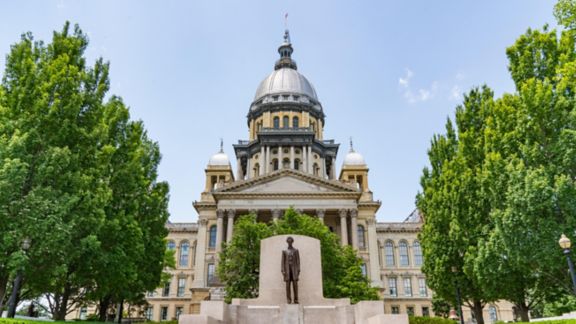NORC’s Live Crime Tracker Shows Major Crime Declines in 2024
For Media Inquiries:
New analysis finds unprecedented drop from 2023 rates across multiple crime categories in 49 U.S. cities.
CHICAGO, January 16, 2025 — According to new data from NORC at the University of Chicago’s Live Crime Tracker, crime rates declined substantially in 49 mid-sized and large U.S. cities in 2024. The analysis by NORC’s Center on Public Safety & Justice found a statistically significant decrease in four of eight traditional crime rate measures in 2024 compared to 2023: homicide (20.9 percent), motor vehicle theft (18.6 percent), burglary (16.8 percent), and larceny/theft (9 percent).
The center’s analysis also found large (but not statistically significant) declines in sex offenses (9.9 percent) and robbery (8.1 percent). In 2024, the simple assault rate was essentially unchanged (a decline of 1.9 percent), and aggravated assault increased (not statistically significantly) by 3.2 percent.
The 2024 decline across multiple crime categories reflects a five-year trend of unparalleled change in crime in the United States compared to historical norms. According to the Federal Bureau of Investigations (FBI), from 2019 to 2020, the homicide rate increased by 28 percent, the largest one-year increase since 1960.
In 2023, preliminary FBI Uniform Crime Reporting (UCR) Program data showed a 12.3 percent decline in homicides, the largest one-year decline since 1960 before 2024. These findings are consistent with the mid-year research brief released by the center in July 2024, which also reported declines across multiple crime categories.
“The noted declines in several major crime categories are consistent with our mid-year reporting and continue to mark a trend of significant decline in crime in our major cities,” said John Roman, director of the Center on Public Safety & Justice at NORC. “While the experiences of residents in specific cities will vary, the general decline in crime levels indicates a new chapter for evaluating which policies and programs will best serve and protect the needs of our communities.”
Table 1: Average Incident Rates per 100k Residents by Type of Offense, 2023 and 2024
| 2023 Rate per 100,000 | 2024 Rate per 100,000 | Difference per 100,000 | Percentage Change | P-value | |
|---|---|---|---|---|---|
| Larceny/Theft Offenses (n=48) | 2,291.85 | 2,086.66 | -205.187 | -9.0% | 0.033 |
| Motor Vehicle Theft (n=48) | 929.66 | 756.97 | -172.69 | -18.6% | 0.001 |
| Simple Assault (n=39) | 805.83 | 790.26 | -15.57 | -1.9% | 0.771 |
| Burglary (n=49) | 576.99 | 480.09 | -96.90 | -16.8% | 0.071 |
| Aggravated Assault (n=46) | 398.4 | 411.32 | 12.97 | 3.2% | 0.749 |
| Robbery (n=49) | 173.04 | 159.1 | -13.94 | -8.1% | 0.358 |
| Sex Offenses (n=36) | 70.85 | 63.81 | -7.04 | -9.9% | 0.198 |
| Homicide Offenses (n=47) | 20.80 | 16.44 | -4.36 | -20.9% | 0.019 |
Source: Live Crime Tracker. https://livecrimetracker.norc.org/. Data from January 1-December 31, 2023, and January 1-December 31, 2024.
The data used in this study can be viewed on the Live Crime Tracker website maintained by NORC’s Center on Public Safety & Justice.
About NORC at the University of Chicago
NORC at the University of Chicago conducts research and analysis that decision-makers trust. As a nonpartisan research organization and a pioneer in measuring and understanding the world, we have studied almost every aspect of the human experience and every major news event for more than eight decades. Today, we partner with government, corporate, and nonprofit clients around the world to provide the objectivity and expertise necessary to inform the critical decisions facing society.
Contact: For more information, please contact Eric Young at NORC at young-eric@norc.org or (703) 217-6814 (cell).
About the Center on Public Safety & Justice
NORC’s Center on Public Safety & Justice develops actionable, evidence-based solutions to crime and victimization. The Center integrates our multidisciplinary team of experts in criminology, demography, economics, and public health and NORC’s industry-leading survey data collection capacity. Our holistic approach and longstanding partnerships with diverse local stakeholders in the hardest-hit communities allow us to identify programming innovations at every societal level.
About the Analysis and Live Crime Tracker
The researchers used publicly available data from local governments and police agencies to examine crime by category from January 1, 2023, to December 31, 2024. The data reported in the report are in a minimally adjusted format. All data from the 49 U.S. cities available were normalized such that the eight crime categories each included the same data across all cities. The online tracker—livecrimetracker.norc.org—provides real-time data for approximately 54 U.S. cities in eight crime categories, including homicide, burglary, and aggravated assault. The Live Crime Tracker includes in-depth city crime profiles, interactive maps, and a daily crime tracker that allows users to analyze trends over time and make comparisons across locations. It should be noted that the tracker compiles data shared by local governments, and some of the data they report is incomplete.









